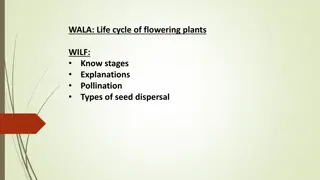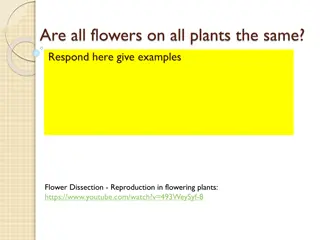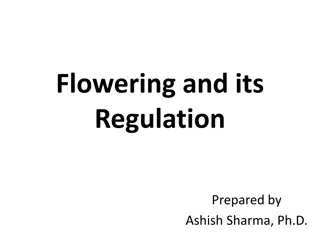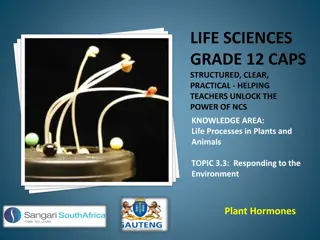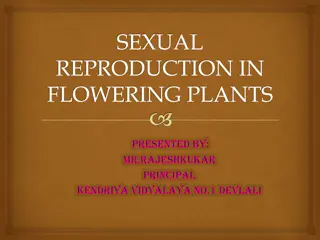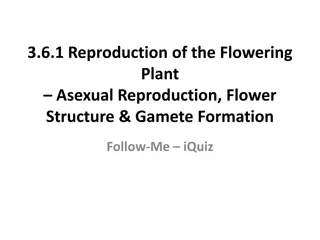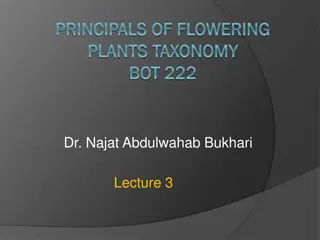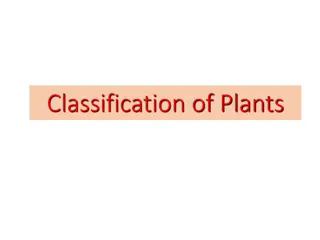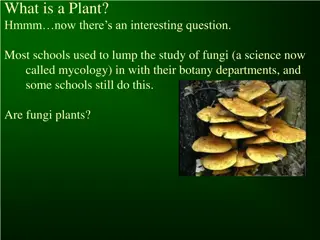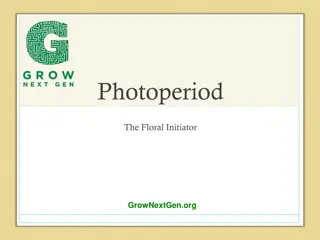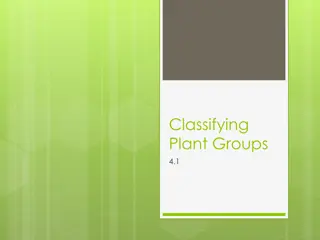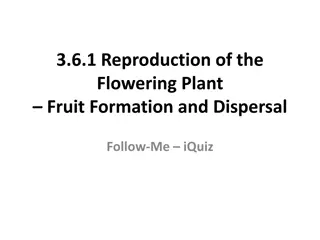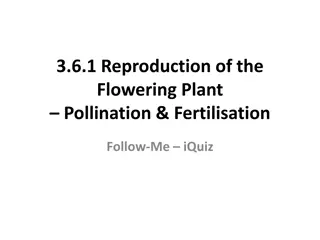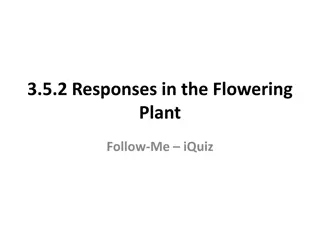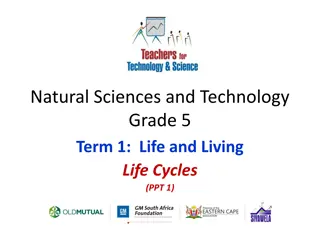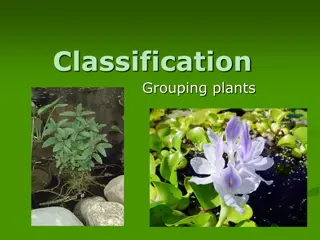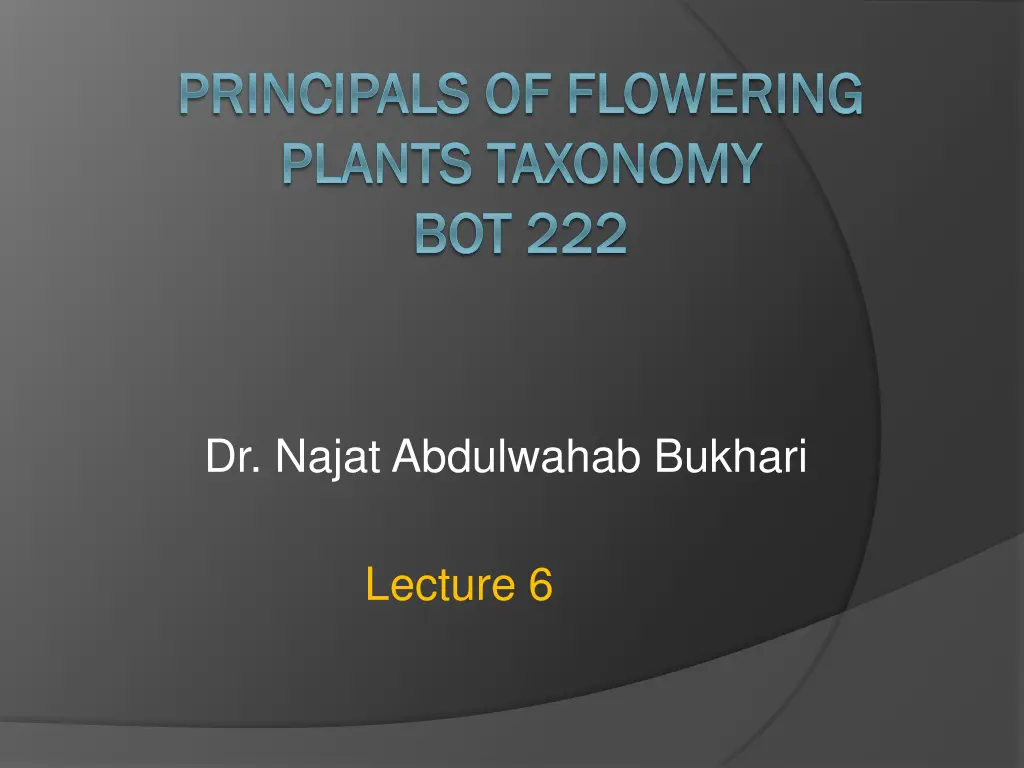
Botany Department Vision and Mission - Developing Scientific Progress
Explore the vision and mission of the Botany department, enhancing academic and research standards to match scientific advancements and societal needs. Dive into topics covering plant taxonomy, aestivation, and more in this comprehensive Botany lecture. Join the journey towards a world-class university shaping Saudi Arabia's knowledge economy.
Download Presentation

Please find below an Image/Link to download the presentation.
The content on the website is provided AS IS for your information and personal use only. It may not be sold, licensed, or shared on other websites without obtaining consent from the author. If you encounter any issues during the download, it is possible that the publisher has removed the file from their server.
You are allowed to download the files provided on this website for personal or commercial use, subject to the condition that they are used lawfully. All files are the property of their respective owners.
The content on the website is provided AS IS for your information and personal use only. It may not be sold, licensed, or shared on other websites without obtaining consent from the author.
E N D
Presentation Transcript
PRINCIPALS OF FLOWERING PRINCIPALS OF FLOWERING PLANTS TAXONOMY PLANTS TAXONOMY BOT 222 BOT 222 Dr. Najat Abdulwahab Bukhari Lecture 6
University Vision and Mission Vision: To be a world-class university and a leader in developing Saudi Arabia s knowledge economy Mission: To provide students with a quality education, conduct valuable research, serve the national and international societies and contribute to Saudi Arabia s knowledge economy through learning, creativity, the use of current and developing technologies and effective international partnership.
Botany department Vision and Mission Vision: upgrading the academic and research to keep pace with scientific progress and requirements of society. Mission: Development of Academic process and develop scientific research through strategic planning and a clear vision for science and technology at the country level. As well as training of national cadres, and the introduction of a methodology developed to meet the different needs of society, and to serve the various research and developmental projects in the community
Course Description Course Description Topics to be Covered Topic No of Weeks Contact hours 1 2 - Historical review of plant taxonomy (industrial , natural, evolution) - Nomenclature - Classic taxonomy (morphological taxonomy of vegetation and floral characters Fruits and seed characters. - Key to taxonomical unites. - Fertilization and seed formation - The different kinds of fruits - The sexual differentiations of flowers and their fertilization 1 5 2 2 1 2 2 2 2 2 2 2 14 14
Aestivation Aestivation Refers to the positional arrangement of the parts of a flower within a flower bud before it has opened.
Classes of aestivation: Classes of aestivation: 1. Sepals or petals in a whorl just meet by their edges without overlapping Valvate:
2. where one tepal is outside all others, one is inside all others, and the others are outside on one margin and inside on the other sepals touch without overlapping. Imbricate: Descending imbricate Ascending imbricate
Descending imbricate: the posterior petal overlaps one margin of the two lateral petals. The other margin of these two lateral petals overlaps the two anterior petals, which are united Ascending imbricate: Here the overlapping of petals begins from the anterior side proceeding towards the posterior side. This is just opposite of descendingly imbricate
3. In this mode of aestivation one margin of each sepal or petal overlaps the next one, and the other margin is overlapped by a preceding one. Here the over-lapping is regular in one direction: Contorated or twisted: Clockwise Anticlockwise
5. Quincunical: in which two petals are internal, external and the fifth one has one margin external and the other margin internal two are
Gynoecium Gynoecium The gynoecium include all the female reproductive organs of a flower. It consists of : ovary , style, and stigma. It is formed of a single or several pistils. Each pistil is composed of one or more fused carpels and produces the ovules.
When in a flower the carpel is single the terms gynoecium and pistil are synonymous. If the carpels (pistils) are free the gynoecium is apocarpous or if the carpels are fused the gynoecium (pistil) is syncarpous (or compound).
1. Ovary: the swollen bottom part of the pistil that contains the ovules or immature seeds.
I. A superior ovary is an ovary attached to the receptacle above the attachment of other floral parts II. Inferior ovary An inferior ovary lies below the attachment of other floral parts Superior ovary III. Ha;f-inferior ovary is embedded or surrounded by the receptacle
1. Simple ovary Consists of one carpel, as in (apricot). 2. Apocatrpous Ovary consist of more than one separated (free) carpals, as in (roses Polyalthia, ). 3. Syncarpous Ovary consist of more than one fused carpals, as in (Hibiscus)
2. Style: The slender part of a pistil between stigma and the ovary. the
Styles differ in lengths it may be long or short ,it might not exist and it could be branched into two or more sections . It can be smooth or it may be poetic, which contains bristles. Sometimes the style develops into a petal shape to attract insects, as in the flowers plant lilies "Iris . The style could be very short or absent as in the poppy flower
Style can be: 1- Apical Style, as in most of the plants families.
3- Basal Style, the top of the ovary could break away and the style could come out of the bottom of the fissure, as in the (Lamiaceae family).
3. Stigma: is the receptive tip of the carpel, which receives pollen at pollination and on which the pollen grain germinates. The stigma is adapted to catch and trap pollen, either by combining pollen of visiting insects or by various hairs, flaps, or sculpturings.
Stigmas can be feathery Plumose, as in wind pollination flowers, (Graminaceae ). Stigmas can be discoid or flat or circular shape or lobulation as in tomatoes. Stigmas can be sticky surface or coarse (Papillate), it can have cube shape. Often sticky . This type of pollination is by insects as the pollens sticks to the insect body.
ovaries can be fused , as the in a flower linum. Ovaries and styles can be fused with free stigmas, number indicates the number of corbels. As in (Geranium) flowers. Fusion could be complete in Ovaries ,styles and stigmas. As in Zygophlium flowers. In addition, there are other types of fusion depends on the types of plants. Fusion is and important character in plant classification


